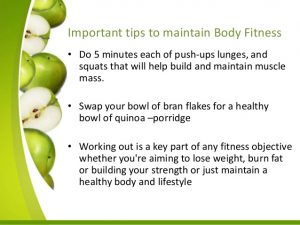
Eating properly is an important part of keeping your body fit. Maintaining good fitness requires careful attention to both diet and exercise. Nutritious food is no substitute for physical activity, but watching what you eat plays a vital role in developing a strong and healthy body. Combine a balanced diet with careful attention to good nutrition while exercising and you’ll ensure the food you eat is keeping you in great shape.
Consume smaller quantities of food toward the top of the food pyramid. The nutrients found in dairy, especially, are important, but on the whole you’ll want to eat top-of-the-pyramid foods sparingly. Follow these guidelines:
· One to two servings of dairy products per day, or vitamin D and calcium supplements if you dislike (or are allergic to) dairy foods.
· Infrequent consumption of red meat, processed meat, and butter. Eat red meat no more than two times per week, and minimize processed meat and butter in your diet.
· Minimal consumption of refined grains such as white rice, white bread, sugary or refined foods, and salt
Consume “super foods” that deliver exceptional nutritional benefits. If your aim is fitness as well as general good health, consider eating foods that deliver extra energy, antioxidants, calcium, or heart-healthy fats and proteins.
· Dried fruits, sweet potatoes, and bananas deliver complex carbohydrates that will help you efficiently store and use energy. Each of these foods contains valuable potassium in addition to a host of other nutrients.
· Broccoli and other green vegetables, tomatoes, blueberries, and cocoa all contain antioxidants that remove cell-damaging free radicals from your blood.
· Milk and green vegetables provide calcium to ensure healthy bones. Warm milk consumed near bedtime has the added benefit of boosting the serotonin and melatonin that help you sleep.
· Salmon and nuts deliver healthy fats and proteins. Consider adding Brazil nuts in particular to your diet, as they contain high levels of selenium, a mineral that helps bolster your immune system
Pay attention to portion size. Read food packaging carefully to determine portion size and the number of servings in a given package. Split value packs into portion-sized containers, and consider sharing large restaurant meals. Learn how to identify proper portions using hand-size references; guidelines are readily available online. One serving of carrots, for example, is equivalent to one cup, or approximately the size of an adult fist; a serving of dry cereal is also one cup, or one adult fist, in size
Leave a Reply